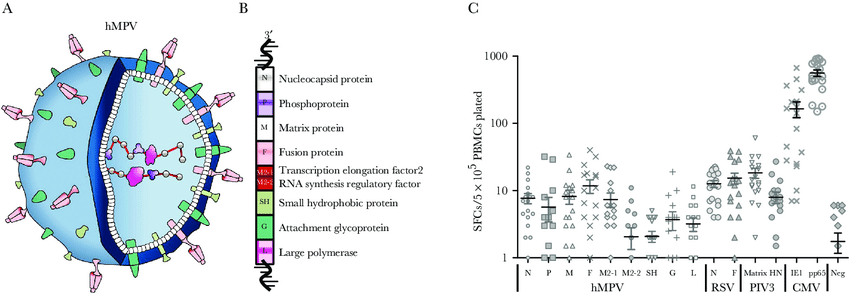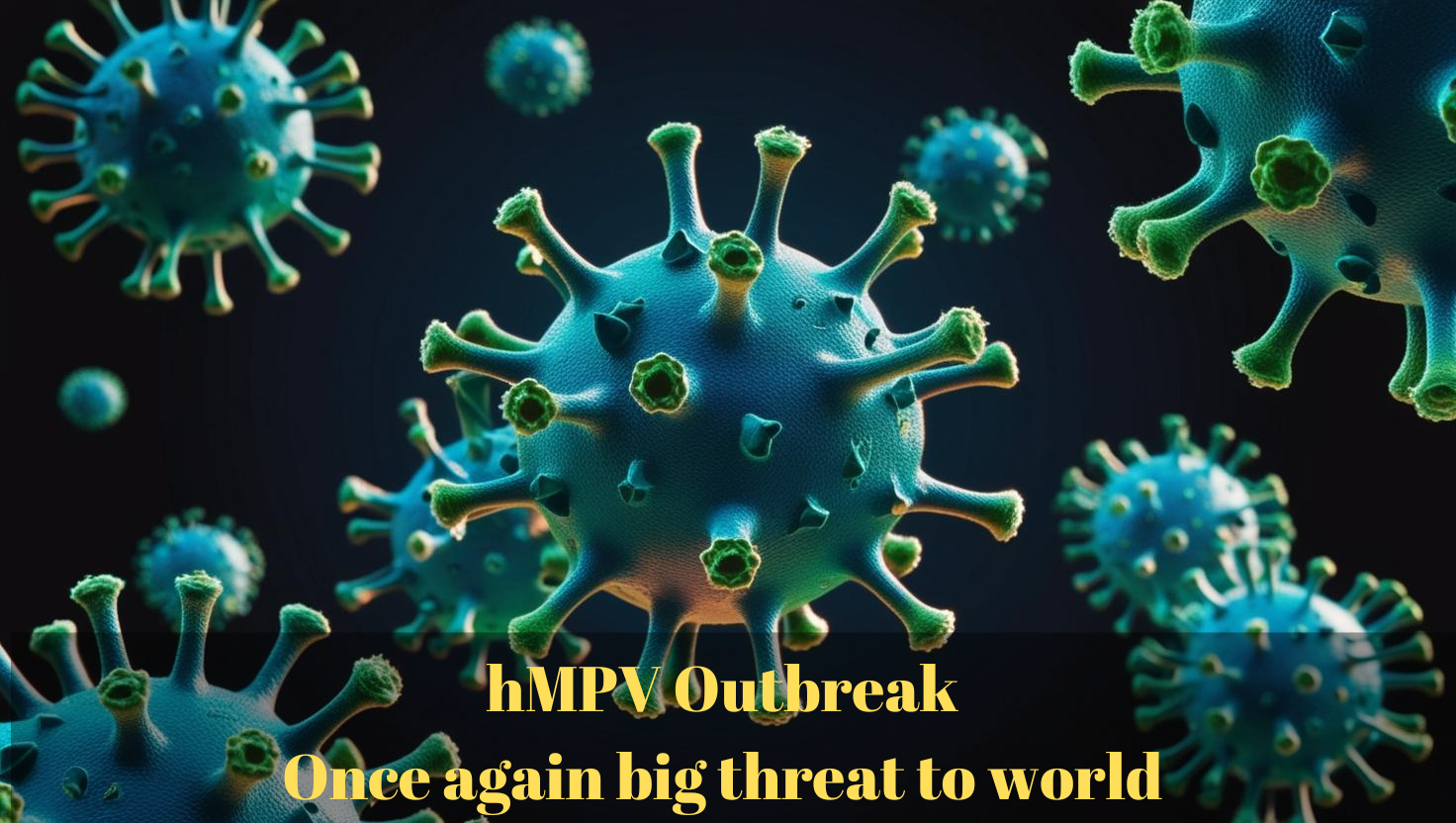HMPV, Human Metapneumovirus, respiratory infections, cold symptoms, virus prevention, respiratory health, HMPV symptoms, respiratory virus awareness, virus in china , hmvp virus , hmpv in china, hpv cases in india, is hmpv virus deadly
HMPV ह्यूमन मेटान्यूमोवायरस को समझना
ह्यूमन मेटान्यूमोवायरस (HMPV) एक ऐसा श्वसन वायरस है जिसे अक्सर अनदेखा कर दिया जाता है और यह वैश्विक स्तर पर कई संक्रमणों के लिए ज़िम्मेदार है। सामान्य सर्दी या फ्लू के लक्षणों की नकल करते हुए, HMPV गंभीर जटिलताओं को जन्म दे सकता है, खासकर बच्चों, बड़े वयस्कों और कमज़ोर प्रतिरक्षा प्रणाली वाले लोगों जैसे…
HMPV को समझना: ह्यूमन मेटान्यूमोवायरस (HMPV) वैश्विक स्तर पर श्वसन संक्रमणों में कम पहचाना जाने वाला लेकिन महत्वपूर्ण योगदानकर्ता है। हालाँकि इसके लक्षण अक्सर सामान्य सर्दी या फ्लू जैसे ही होते हैं, लेकिन HMPV की एक अनूठी पहचान और प्रभाव है जिस पर ध्यान देने की ज़रूरत है। इस लेख में, हम HMPV के बारे में विस्तृत जानकारी देंगे—यह क्या है, यह कैसे फैलता है, इसके लक्षण और निवारक उपाय
HMPV क्या है?
HMPV, या ह्यूमन मेटान्यूमोवायरस, पैरामाइक्सोविरिडे परिवार से संबंधित है, जो रेस्पिरेटरी सिंकाइटियल वायरस (RSV) के साथ समानताएँ साझा करता है। 2001 में ही पहचाने जाने के बावजूद, शोधकर्ताओं का मानना है कि HMPV ने सदियों से मनुष्यों को प्रभावित किया है। यह वायरस मुख्य रूप से ऊपरी और निचले श्वसन पथ को लक्षित करता है, जिससे व्यक्ति के स्वास्थ्य और उम्र के आधार पर हल्के से लेकर गंभीर लक्षण हो सकते हैं।
कुछ बेहतर ज्ञात वायरसों के विपरीत, HMPV एक घरेलू नाम नहीं है। हालाँकि, यह श्वसन संक्रमण का एक सामान्य कारण है और इससे गंभीर स्वास्थ्य समस्याएँ हो सकती हैं, खासकर कमज़ोर आबादी में। HMPV के प्रभाव को समझना खुद को और अपने प्रियजनों को बचाने का पहला कदम है।
HMPV कैसे फैलता है?
HMPV श्वसन बूंदों के माध्यम से फैलता है – जब कोई संक्रमित व्यक्ति खांसता, छींकता या बात करता है तो निकलने वाले छोटे कण। ये बूंदें आस-पास के लोगों द्वारा साँस में ली जा सकती हैं या सतहों पर गिर सकती हैं। यदि कोई दूषित सतह को छूता है और फिर अपने चेहरे, खासकर अपने मुँह, नाक या आँखों को छूता है, तो उसे संक्रमण का खतरा होता है।
यह वायरस स्कूल, डेकेयर सेंटर, नर्सिंग होम और सार्वजनिक परिवहन जैसी भीड़-भाड़ वाली जगहों पर पनपता है। मौसमी पैटर्न बताते हैं कि HMPV संक्रमण सर्दियों के अंत और वसंत में अधिक आम है, हालाँकि मामले साल भर हो सकते हैं।
इससे होने वाले जोखिम को कम करने के लिए, विशेष रूप से पीक सीजन के दौरान, अच्छी स्वच्छता प्रथाओं को अपनाना आवश्यक है।
HMPV एचएमपीवी के सामान्य लक्षण
एचएमपीवी का अक्सर निदान न हो पाने का एक कारण यह है कि यह अन्य श्वसन संक्रमणों से मिलता-जुलता है। इसके लक्षण हल्के से लेकर गंभीर तक हो सकते हैं और इनमें शामिल हो सकते हैं:
HMPV एचएमपीवी को समझना
खांसी: लगातार खांसी आना इसके मुख्य लक्षणों में से एक है।
नाक बंद होना: नाक बंद होना या बहना एक आम शिकायत है।
गले में खराश: कई व्यक्तियों को निगलते समय असुविधा का अनुभव होता है।
बुखार: अन्य लक्षणों के साथ हल्का से मध्यम बुखार भी हो सकता है।
घरघराहट: गंभीर मामलों या अंतर्निहित स्थितियों वाले व्यक्तियों में अधिक आम है।
सांस की तकलीफ: यह ब्रोंकाइटिस या निमोनिया जैसी जटिलताओं का संकेत हो सकता है।
स्वस्थ व्यक्तियों में, ये लक्षण अक्सर एक से दो सप्ताह में ठीक हो जाते हैं। हालाँकि, वायरस कुछ आबादी में अधिक गंभीर जटिलताएँ पैदा कर सकता है।
सबसे ज़्यादा जोखिम किसे है?
हालाँकि एचएमपीवी किसी को भी संक्रमित कर सकता है, लेकिन कुछ समूहों में गंभीर बीमारी का जोखिम अधिक होता है:
शिशु और छोटे बच्चे: कम विकसित प्रतिरक्षा प्रणाली वाले बच्चों में गंभीर श्वसन लक्षण होने की संभावना अधिक होती है।
वृद्ध वयस्क: उम्र बढ़ने से संक्रमण से लड़ने की प्रतिरक्षा प्रणाली की क्षमता कम हो जाती है, जिससे बुजुर्ग अधिक असुरक्षित हो जाते हैं।
प्रतिरक्षा में कमी वाले व्यक्ति: कैंसर, एचआईवी या प्रतिरक्षादमनकारी दवाओं के उपयोग जैसी स्थितियों से गंभीर HMPV-संबंधी जटिलताओं का जोखिम बढ़ जाता है।
दीर्घकालिक श्वसन संबंधी स्थितियों वाले लोग: अस्थमा, क्रॉनिक ऑब्सट्रक्टिव पल्मोनरी डिजीज (COPD) या अन्य फेफड़ों की बीमारियों वाले व्यक्ति गंभीर लक्षणों का अनुभव कर सकते हैं।
इन उच्च जोखिम वाले समूहों को पहचानने से निवारक उपायों और प्रारंभिक चिकित्सा हस्तक्षेप को प्राथमिकता देने में मदद मिल सकती है।
HMPV को समझना और HMPV का निदान करना
HMPV का निदान करना सीधा नहीं है क्योंकि इसके लक्षण फ्लू, RSV और COVID-19 जैसी अन्य श्वसन संबंधी बीमारियों के साथ ओवरलैप होते हैं। स्वास्थ्य सेवा प्रदाता HMPV संक्रमण की पुष्टि करने के लिए विशेष परीक्षणों पर भरोसा करते हैं। इन परीक्षणों में शामिल हैं:

पॉलीमरेज़ चेन रिएक्शन (PCR) परीक्षण: ये उच्च सटीकता के साथ वायरस की आनुवंशिक सामग्री का पता लगाते हैं।
एंटीजन डिटेक्शन: यह विधि HMPV से जुड़े विशिष्ट प्रोटीन की पहचान करती है।
छाती का एक्स-रे या सीटी स्कैन: गंभीर मामलों में, निमोनिया जैसी जटिलताओं की जांच के लिए इमेजिंग का उपयोग किया जा सकता है।
एंटीजन डिटेक्शन: यह विधि HMPV से जुड़े विशिष्ट प्रोटीन की पहचान करती है।
चेस्ट एक्स-रे या सीटी स्कैन: गंभीर मामलों में, निमोनिया जैसी जटिलताओं की जाँच के लिए इमेजिंग का उपयोग किया जा सकता है।
उपचार और प्रबंधन
वर्तमान में, HMPV के लिए कोई विशिष्ट एंटीवायरल दवा या टीका नहीं है। उपचार लक्षणों से राहत देने और शरीर की प्राकृतिक रिकवरी प्रक्रिया का समर्थन करने पर केंद्रित है। मुख्य दृष्टिकोणों में शामिल हैं:
आराम: अपने शरीर को ठीक होने के लिए आवश्यक समय दें।
हाइड्रेशन: तरल पदार्थ पीने से शरीर के इष्टतम कार्यों को बनाए रखने में मदद मिलती है और गले में खराश और कंजेशन जैसे लक्षणों को कम करता है।
ओवर-द-काउंटर दवाएँ: दर्द निवारक, डिकॉन्गेस्टेंट और बुखार कम करने वाली दवाएँ असुविधा को कम करने में मदद कर सकती हैं।
चिकित्सकीय सहायता लें: यदि लक्षण बिगड़ते हैं या बने रहते हैं, तो स्वास्थ्य सेवा प्रदाता से परामर्श करें, खासकर यदि आप उच्च जोखिम वाले समूह से संबंधित हैं।
अस्पताल में भर्ती होने की आवश्यकता वाले गंभीर मामलों के लिए, उपचार में पूरक ऑक्सीजन या यांत्रिक वेंटिलेशन शामिल हो सकते हैं।
HMPV को रोकना
HMPV के प्रभाव को कम करने के लिए रोकथाम सबसे अच्छा तरीका है। यहाँ कुछ व्यावहारिक कदम दिए गए हैं:
बार-बार हाथ धोना: कम से कम 20 सेकंड के लिए साबुन और पानी से हाथ धोना।
हैंड सैनिटाइज़र का उपयोग करें: साबुन और पानी उपलब्ध न होने पर अल्कोहल-आधारित हैंड सैनिटाइज़र एक सुविधाजनक विकल्प है।
नज़दीकी संपर्क से बचें: श्वसन संबंधी समस्याओं वाले लोगों से अपनी दूरी बनाए रखें।
साफ़ सतहें: फ़ोन, कीबोर्ड और दरवाज़े के हैंडल जैसी बार-बार इस्तेमाल की जाने वाली वस्तुओं को साफ़ रखें।
खाँसते और छींकते समय मुँह को ढँकें: बूंदों को फैलने से रोकने के लिए टिशू या अपनी कोहनी का उपयोग करें।
बीमार होने पर घर पर रहें: घर पर आराम करने से वायरस दूसरों में फैलने से बचता है। ये सरल उपाय न केवल HMPV के विरुद्ध बल्कि अन्य श्वसन संबंधी बीमारियों के विरुद्ध भी प्रभावी हैं।
जागरूकता क्यों महत्वपूर्ण है?
एक सामान्य वायरस होने के बावजूद, HMPV को अक्सर इसके गैर-विशिष्ट लक्षणों के कारण अनदेखा कर दिया जाता है।
जागरूकता बढ़ने से निम्न हो सकते हैं:
समय पर चिकित्सा ध्यान: लक्षणों को जल्दी पहचानना जटिलताओं को कम कर सकता है।
बेहतर स्वास्थ्य परिणाम: उच्च जोखिम वाले व्यक्ति वायरस के बढ़ने से पहले आवश्यक देखभाल प्राप्त कर सकते हैं।
सूचित रोकथाम: जागरूकता वायरस के प्रसार को कम करने के लिए सक्रिय कदम उठाने को बढ़ावा देती है। स्वास्थ्य सेवा प्रदाताओं, माता-पिता और देखभाल करने वालों को कमज़ोर आबादी की भलाई सुनिश्चित करने के लिए HMPV के बारे में जानकारी रखनी चाहिए।
अंतिम विचार
मानव मेटान्यूमोवायरस भले ही घर-घर में जाना-पहचाना नाम न हो, लेकिन श्वसन स्वास्थ्य पर इसके प्रभाव को नकारा नहीं जा सकता। इसके लक्षणों, संचरण और रोकथाम को समझकर, हम खुद को और अपने समुदायों को बेहतर तरीके से सुरक्षित कर सकते हैं। जबकि अधिकांश मामले हल्के होते हैं, HMPV कुछ आबादी में गंभीर बीमारी का कारण बन सकता है, जिससे सतर्कता आवश्यक हो जाती है। अगर आपको या आपके किसी जानने वाले को लगातार श्वसन संबंधी लक्षण महसूस हो रहे हैं, तो डॉक्टर से सलाह लेने में संकोच न करें। उचित देखभाल और समय रहते निदान से बहुत फर्क पड़ सकता है।
जानकारी रखें, अच्छी स्वच्छता का अभ्यास करें और HMPV जैसे श्वसन वायरस को दूर रखने के लिए अपने स्वास्थ्य को प्राथमिकता दें।
HMPV, ह्यूमन मेटान्यूमोवायरस, श्वसन संक्रमण, सर्दी के लक्षण, वायरस की रोकथाम, श्वसन स्वास्थ्य, HMPV लक्षण, श्वसन वायरस जागरूकता
FAQ’s
ह्यूमन मेटाप्न्यूमोवायरस (HMPV) क्या है?
ह्यूमन मेटाप्न्यूमोवायरस (HMPV) एक श्वसन वायरस है जो पैरामिक्सोविरिडे परिवार से संबंधित है। यह ऊपरी और निचले श्वसन तंत्र में संक्रमण का कारण बनता है और विशेष रूप से छोटे बच्चों और बुजुर्गों जैसी संवेदनशील आबादी के लिए महत्वपूर्ण होता है।
HMPV कैसे फैलता है?
HMPV मुख्य रूप से श्वसन बूंदों के माध्यम से फैलता है, जो तब निकलती हैं जब कोई संक्रमित व्यक्ति खांसता, छींकता या बात करता है। यह दूषित सतहों को छूने और फिर मुंह, नाक या आंखों को छूने से भी फैल सकता है।
HMPV के सामान्य लक्षण क्या हैं?
HMPV के लक्षणों में लगातार खांसी, नाक बंद होना, गले में खराश, बुखार, घरघराहट और सांस लेने में कठिनाई शामिल हैं। ये लक्षण व्यक्ति के स्वास्थ्य के आधार पर हल्के से लेकर गंभीर तक हो सकते हैं।
कौन से लोग गंभीर HMPV संक्रमण के अधिक जोखिम में हैं?
गंभीर HMPV संक्रमण के लिए उच्च जोखिम वाले समूहों में शिशु, छोटे बच्चे, बुजुर्ग, कमजोर प्रतिरक्षा प्रणाली वाले व्यक्ति और अस्थमा या सीओपीडी जैसी पुरानी श्वसन स्थितियों वाले लोग शामिल हैं।
क्या HMPV के लिए कोई विशेष उपचार है?
वर्तमान में, HMPV के लिए कोई विशिष्ट एंटीवायरल दवा या टीका उपलब्ध नहीं है। उपचार मुख्य रूप से लक्षणों के प्रबंधन पर केंद्रित है, जिसमें आराम, हाइड्रेशन और बुखार व जकड़न को कम करने के लिए ओवर-द-काउंटर दवाओं का उपयोग शामिल है।
HMPV संक्रमण को कैसे रोका जा सकता है?
रोकथाम के उपायों में बार-बार हाथ धोना, हैंड सैनिटाइज़र का उपयोग करना, बीमार व्यक्तियों के निकट संपर्क से बचना, अक्सर छूई जाने वाली सतहों को कीटाणुरहित करना और बीमार होने पर घर पर रहना शामिल है।
HMPV के बारे में जागरूकता क्यों महत्वपूर्ण है?
HMPV के बारे में जागरूकता महत्वपूर्ण है क्योंकि यह जल्दी निदान, समय पर चिकित्सा देखभाल और उच्च जोखिम वाले समूहों के लिए बेहतर स्वास्थ्य परिणामों में मदद करती है। यह वायरस के प्रसार को कम करने के लिए प्रभावी रोकथाम रणनीतियों को भी बढ़ावा देती है।
Another Study Read Here: HMPV Infection and why world should be worried.



Pingback: HMPV Outbreak in China: What It Means for Global Health